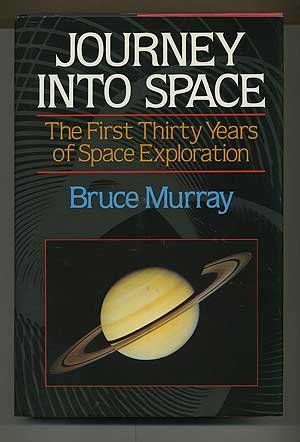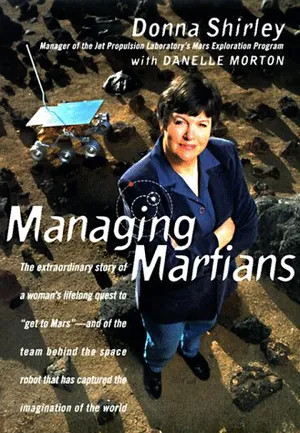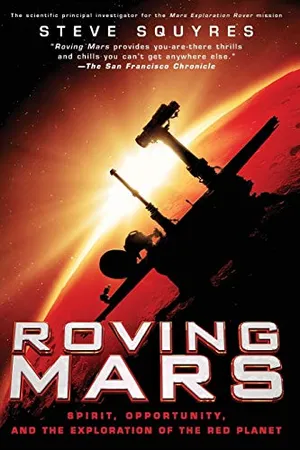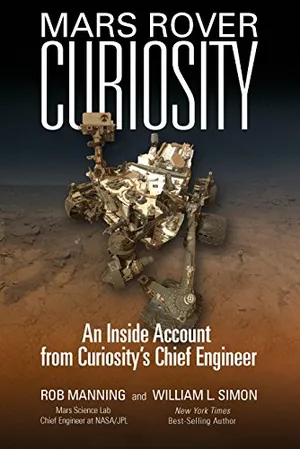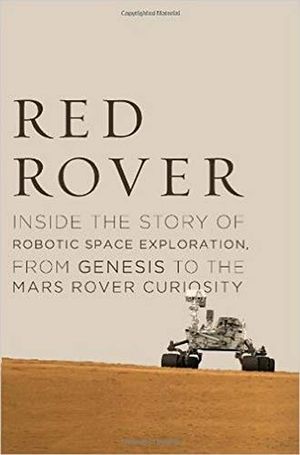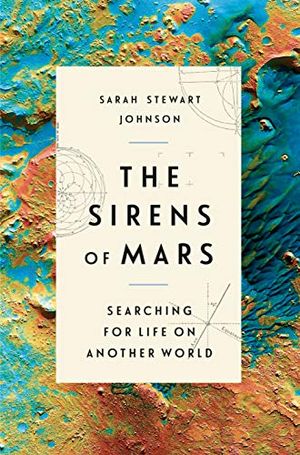The Best Books About Mars, By the Mars Explorers Themselves
Firsthand accounts of Mars exploration by the people who run the robots.
:focal(1478x783:1479x784)/https://tf-cmsv2-smithsonianmag-media.s3.amazonaws.com/filer/2b/e5/2be5f262-4090-492d-bf12-df3b26a78d9b/insight_landing.jpg)
Most of the astronauts who traveled to the moon 50 years ago, having been asked incessantly What was it like?, wrote books about the experience. We’ve heard less from the many more people who’ve visited Mars over that same half century.
And with good reason. The actual, wheels-on-the-ground exploring is done by robots. But talk to the Curiosity rover drivers who work on another world every day, or listen to the scientists who devoted their careers to past Mars missions like Viking and Pathfinder, and you’ll see the warm-blooded humans behind the machines. Here are some notable books by those fortunate few who’ve already, in a sense, become Martians. To quote one of them, Sarah Stewart Johnson, “We’ve built an entire field of science around something we can barely see in the night.”
Journey into Space: The First Three Decades of Space Exploration
Most U.S. Mars missions have been run from a single place: NASA’s Jet Propulsion Laboratory in California. Bruce Murray was JPL’s director toward the end of the golden age of planetary exploration, taking over in 1976 just as Vikings 1 and 2 were about to make the first Mars landings. Years earlier, he had been on the team that built the first Mars TV cameras, for Mariner 4’s quick flyby. Through the rest of the 1960s and 1970s he had a front-row seat for the first wave of Mars spacecraft missions, when the planet evolved in our sight from a tiny disk in Earth-bound telescopes to a world of mountains, deserts, and salmon-colored skies.
Murray’s book, which covers more than Mars (he also was a key scientist on the Mariner 10 Mercury mission), is equal parts history and memoir. He was on hand in 1965 when Mariner 4’s “long-awaited first close-up pictures of Mars started trickling into JPL at a rate of slightly more than one tiny [pixel] each second.” At first the scientists “couldn’t recognize a thing,” but eventually the fuzzy images revealed what seemed to be a dead, cratered world. The pictures got sharper with each mission, though, until in 1971 Mariner 9’s views of dried-up river channels made the planet’s geologic past come alive. Murray thought the first landing mission was overly focused on finding life (“I was a critic, not a supporter of Viking”) and in fact, Viking’s ambiguous maybe regarding biology put a chill on Mars exploration for another two decades.
The second half of Journey Into Space sometimes gets bogged down in NASA budget politics, but along the way Murray introduces us to some of the pioneers of planetary exploration, from less well known figures like John Casani and Ed Danielson to famous ones like Carl Sagan, who, along with Murray, would later co-found The Planetary Society.
Also see: A Bunch of Plumbers by John Newcomb, a veteran engineer on several early planetary missions, including Viking; and this online exhibit about Viking, with many behind-the-scenes photos.
Managing Martians
More than 20 years after Viking, NASA returned to the Martian surface with the Pathfinder lander and a tiny rolling sidekick named Sojourner. It was more a technology test than a full-up Mars mission—NASA’s mantra in the 1990s was “better, faster, cheaper”—and Donna Shirley headed the team that built the 25-pound wheeled rover. “No one at JPL gave our rover project much of a chance,” she recalled. “We had a budget of $25 million at a time when billion-dollar projects were the norm.” But succeed Sojourner did, lasting three months on the planet instead of the one week it was designed for.
Growing up a “smart, mouthy tomboy” in Oklahoma, with a domineering mother whom she credited for making her “fearless,” Shirley had dreams of flying over Mars. But when she arrived at JPL in 1966 it was still strictly a man’s world. “I was the only female with an engineering degree out of about 2,000 engineers.” All the more impressive, then, that she eventually rose to head JPL’s Mars program.
Her Sojourner rover, along with other innovations like Pathfinder’s bouncing-airbag landing system, made Mars exploration new and cool again at the close of the 20th century. For the generation that grew up on Star Wars, she wrote, “the Pathfinder mission was akin to Neil Armstrong’s moon landing.”
Roving Mars: Spirit, Opportunity, and the Exploration of the Red Planet
Steve Squyres comes from planetary exploration’s other tribe—the scientists, mostly from universities, who build the cameras, spectrometers, and other instruments on the rovers, then interpret the data they collect. Squyres was principal scientist for the Spirit and Opportunity missions launched in 2003, which brought real mobility to Mars exploration. Designed to last three months, both rovers blew far past that goal (Opportunity traveled 28 miles before finally going silent in 2018). While the first half of Squyres’ book details the engineering travails of getting to Mars, the second half is written in diary style, and focuses on the first year that he and other scientists, along with a dedicated crew of rover drivers, operated the spacecraft on the surface, learning to live on sleep-disrupting “Martian time” where the day is 39 minutes longer than it is on Earth.
Intense and ambitious, Squyres (who left Cornell in 2019 to become chief scientist at Jeff Bezos’ Blue Origin) sometimes sounds like a hard guy to work with. But his passion often overflows the page, as when he writes, “A word like love is one to be used advisedly, especially when talking about pieces of metal. But I love Spirit and Opportunity.”
Also see: Scott Maxwell’s Mars Rover Driver, written for young readers, and the online diary he kept during a few of his nine years on the Spirit and Opportunity rover driver team.
Mars Rover Curiosity: An Inside Account from Curiosity's Chief Engineer
If you’ve ever wondered how it feels to be one of those mission controllers white-knuckling it during the final “seven minutes of terror” of a Mars landing, knowing that millions of dollars and years of work are on the line but there’s nothing you can do now but watch, well, Rob Manning can tell you. “It’s as if the person you love most dearly is in a building that’s been devastated by some errant force of nature and you are waiting to hear if she or he is still alive and uninjured,” he writes in this engaging memoir co-authored with journalist William L. Simon.
Now the Chief Engineer at JPL, Manning played a central role in designing Mars rovers from Spirit and Opportunity to the one-ton Curiosity that’s still roaming the planet after almost nine years. He and his teams put in long hours inventing and testing novel technologies like the “Skycrane” rover-on-a-rope landing system—all under punishing schedule and budget pressure, while still finding time to take his two-year-old to the zoo for her birthday. Mars project managers may look calm on TV, but behind the scenes there’s plenty of strong emotion. On one particularly tense day, when some last-minute problem made it seem Spirit might miss its launch date, Manning admits with embarrassment, “I screamed. I threw my pen to the ground and it split open—in the middle of the spotless clean room.” In 1999, waiting for radio confirmation that the Mars Polar Lander had arrived safely, then realizing it had “gone splat” instead, “I was suddenly gripped by an attack of nausea.”
All part of the deal for Mars explorers. “In this work,” Manning writes, “it’s not a question just of being good at what we do, but of being good at picking ourselves up. We live with the knowledge that failure is ingrained in the effort.”
Also see: Published two years after Manning’s book, Adam Steltzner’s The Right Kind of Crazy covers roughly the same time period at JPL and tells some of the same stories, but with Steltzner’s trademark rock-and-roll attitude mixed with advice for innovators of all types. The technical lead for Curiosity’s landing system, Steltzner will be in the hot seat again as Chief Engineer for Perseverance.
Red Rover: Inside the Story of Robotic Space Exploration, from Genesis to the Mars Rover Curiosity
Planetary scientists work under a handicap: Their laboratory is millions of miles away. Getting there requires competing with other researchers vying to get their instrument on one of NASA’s outbound spacecraft, followed by years of planning, building, testing, and waiting before ever seeing a scrap of data. Roger Wiens of the Los Alamos National Laboratory learned this difficult business on the 2001 Genesis mission to capture samples of the solar wind, then had an instrument accepted for Curiosity, called ChemCam, to study the chemistry of Mars rocks.
At Los Alamos he had seen his first demonstration of a technique called LIBS, for laser-induced breakdown spectroscopy—a fancy name for zapping a rock with a laser, then observing the resulting flash to determine the rock’s chemical makeup. For Curiosity, he had to get this complex instrument to work under the tight power and volume constraints of a spacefaring robot. When he shared his daily struggles at the family dinner table, his teenage boys would laugh, “Dad, how are you doing with the fiber bundles today? Are they still a disaster?”
Red Rover may get too far down in the engineering weeds for some readers, and it ends with Curiosity’s landing, so very little of it takes place on Mars. (Update: ChemCam worked, and Wiens’ more advanced laser-packing successor, SuperCam, will soon arrive on Mars with Perseverance.) But this short book gives you a detailed profile of a particular kind of Mars instrument scientist who, because they lack pretty pictures to show off at news conferences, aren’t generally in the spotlight.
Postcards from Mars: The First Photographer on the Red Planet
Jim Bell of Arizona State University subtitled this coffee-table book “The First Photographer on the Red Planet,” and he’s not bragging. He’s been involved in designing and building the cameras for every one of the rovers NASA has sent to Mars in this century. He developed the ”Pancam” for Spirit and Opportunity, and was deputy principal investigator for Curiosity’s “Mastcam” (the PI for that one, Mike Malin of Malin Space Science Systems in San Diego, is the only other reasonable claimant to the title of Chief Martian Photographer). Now Bell is the lead scientist for the most advanced camera ever sent to Mars, the “Mastcam-Z” on Perseverance (which is built by Malin’s company).
Bell is also a dedicated popularizer of space science, as this reader-friendly book shows. Published in 2006, it covers only the early explorations of Spirit and Opportunity. (If you want more recent photos from Curiosity, you can find your fill online.) In short essays Bell describes the difficulties of taking pictures on a cold, dusty, alien world. His captions, as you might expect from a planetary geologist, are informative. But mostly, Postcards from Mars lets the pictures do the talking.
Also see: Some of the prettiest Mars photos aren’t taken on the surface but from orbit. The HiRISE camera on the Mars Reconnaissance Orbiter has been steadfastly circling the planet since 2006, and principal investigator Alfred McEwen’s coffee table book Mars: The Pristine Beauty of the Red Planet presents some of the best of these images, many of which have the quality of abstract paintings.
The Sirens of Mars: Searching for Life on Another World
The most poetic of these accounts in terms of style and ambition, The Sirens of Mars does more than just describe what it’s like to work on a Mars mission—although Sarah Stewart Johnson does that, too, having been a member of Curiosity’s science team. A rising star in a new generation of planetary scientists, (she was born after the Viking landings) she heads a lab at Georgetown University studying ways to detect “biosignatures” that would identify life on other worlds. Johnson tells vivid stories about fieldwork in Australia or the feel of simulated Mars dust on her tongue. (“It wasn’t blood I was tasting, just the sick-sweet tinge of iron hanging in the air.”) But the book is less about her than about humanity’s fascination with Mars, from Galileo to Percival Lowell to the space age. Some of this is familiar territory—you’ll find that in every history of the Red Planet—but along the way Johnson introduces us to some of her mentors, not the least of which was her father, who as a teenager in Kentucky followed the early Mars missions with fervent attention.
It’s as inviting a short history of Mars exploration as you’ll find, and perfect background reading to get ready for the arrival of Perseverance in Jezero Crater.
Having trouble seeing our list of books? Turn off your ad blocker and you should be all set. By buying a product through these links, Air & Space magazine may earn a commission. 100 percent of our proceeds go to supporting the Smithsonian Institution.
A Note to our Readers
Smithsonian magazine participates in affiliate link advertising programs. If you purchase an item through these links, we receive a commission.
